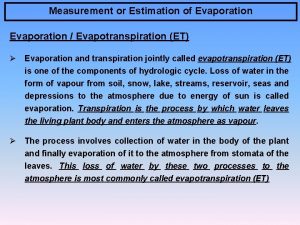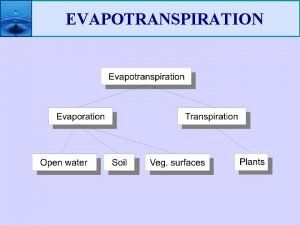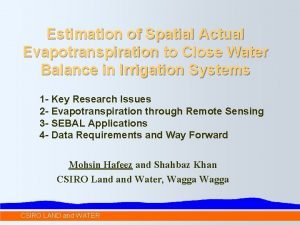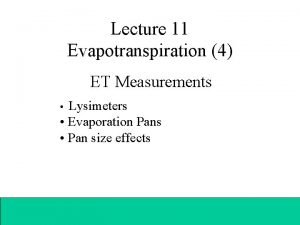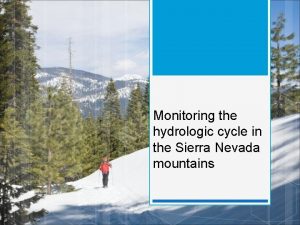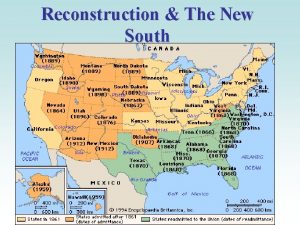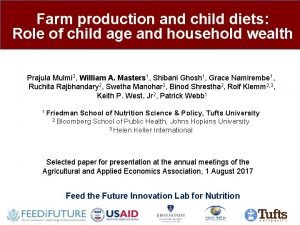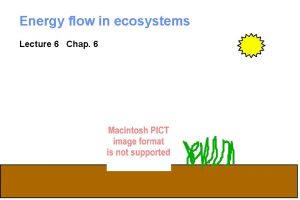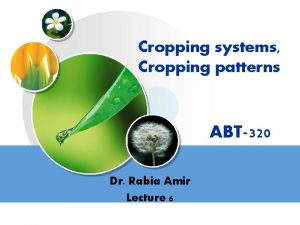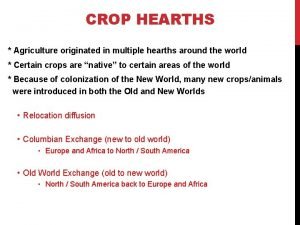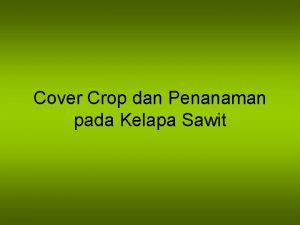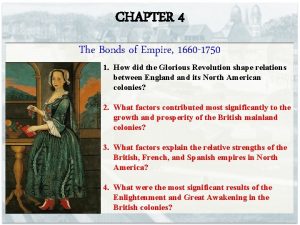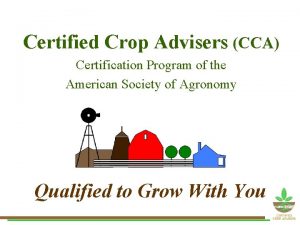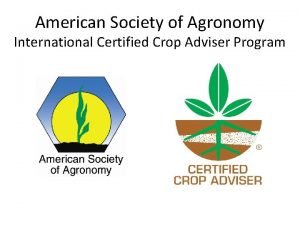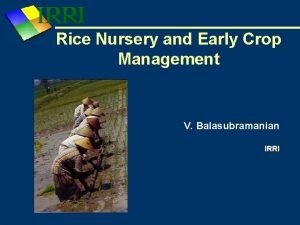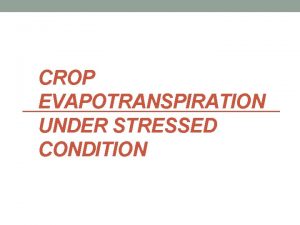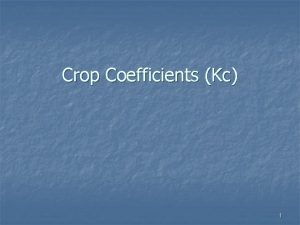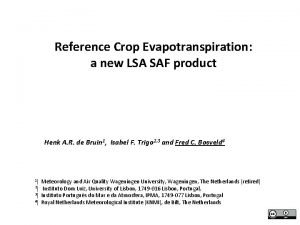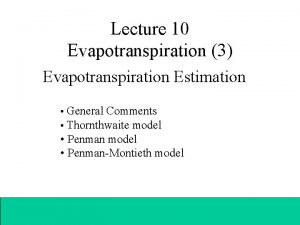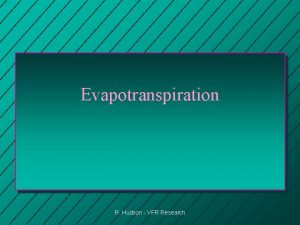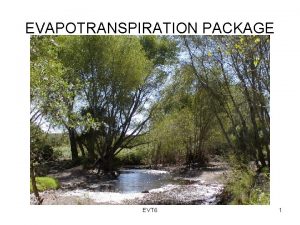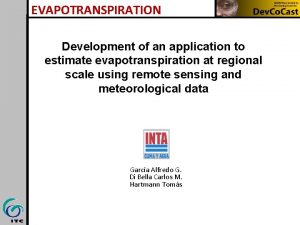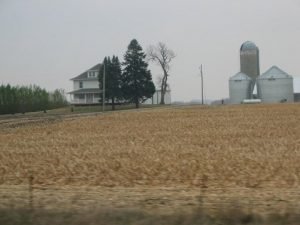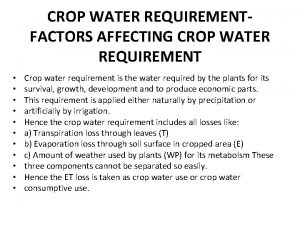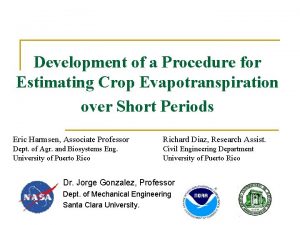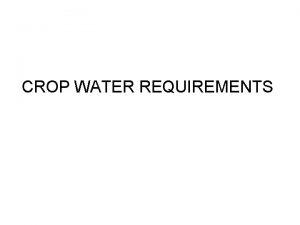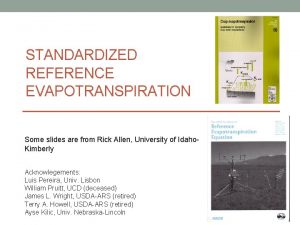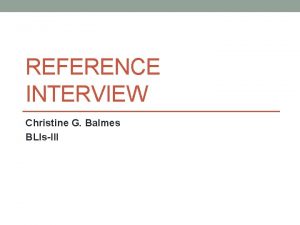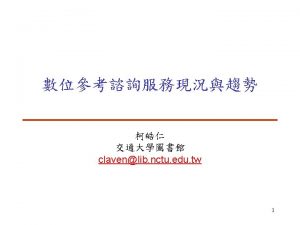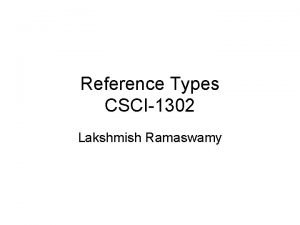Types of Evapotranspirations n n Reference crop evapotranspiration






























- Slides: 30

Types of Evapotranspirations n n Reference crop evapotranspiration (ETo) Crop evapotranspiration under standard conditions (ET c) and Crop evapotranspiration under various management and environmental conditions (ETc adj). Units: Depth of water per unit time (mm/day) n n n Can also be expressed in units of Energy per unit area per unit time (MJ. m-2. day-1) About 2. 45 MJ/m 2 are required for evaporation of a mm of water (depends on latent heat of vaporization =2. 501 -0. 002362 T) MJ. Kg-1. [1 kg water=1 litre= 0. 001 m 3= 0. 001 m (1 mm) water over 1 m 2 area] The evapo-transpiration rate expressed in units of MJ m-2 day-1 is represented by λET, the latent heat flux. 1

Types of Evapotranspirations 2

Variation of Evaporation and Transpiration 3

Types of Evapotranspirations Kc are estimated through experiments 4

Transpiration through Stomata 5

Sample ETo 6

Comparison of various methods by ASCE and EU ASCE Committee compared ETo computed from 20 different methods with ETo measured from Lysimeter results of 11 carefully selected experiments in different climatic conditions. Following are major findings regarding 4 methods of FAO-24 (Blaney Criddle, Modified Penmann, Radiation, Pan Evaporation); n n n The Modified Penman methods over estimate (upto 20%) & it may require local calibration of the wind function to achieve satisfactory results. The Radiation Methods show good results in humid climates where the aerodynamic term is relatively small, but performance in arid conditions is erratic and tends to underestimate evapotranspiration. Temperature methods remain empirical and require local calibration in order to achieve satisfactory results. A possible exception is the 1985 Hargreaves’ method which has shown reasonable ETo results with a global validity. Pan evapotranspiration methods clearly reflect the shortcomings of predicting crop evapotranspiration from open water evaporation. The methods are susceptible to the microclimatic conditions under which the pans are operating and the rigour of station maintenance. Their performance proves erratic. The relatively accurate and consistent performance of the Penman-Monteith approach in both arid and humid climates has been indicated in both the ASCE and European studies. 7 Ref: Page 17 -18, Chap-2, FAO-56

Penman-Monteith Equation Where: ET = Latent heat flux , Energy MJ m-2 day-1 (Divide by 2. 45 to convert it to mm/day) Rn is the net radiation, G is the soil heat flux, (es - ea) represents the vapour pressure deficit of the air, ρa is the mean air density at constant pressure, cp is the specific heat of the air, Δ is the slope of saturation vapour pressure vs Temp curve, g is the psychrometric constant, and rs and ra are the (bulk) surface and aerodynamic resistances. 8

Aerodynamic resistance (ra) Zom=0. 123 h, and Zoh=0. 0123 h, d=0. 67 h where h is height of crop For Reference crop of height 0. 12 m and a standardized height for wind speed, temperature and humidity at 2 m (zm = zh = 2 m), the aerodynamic resistance ra [s m-1] =208/u 2 9

Aerodynamical resistance over hypothetical reference crop 10

If wind is not measured at standard height of 2 m 11

Surface resistance (rs) LAI = Leave Area/Soil Area Active LAI = Sun-lit area of canopy for Reference Crop: LAIactive = 0. 5 LAI = 24 h h = height of crop = 0. 12 m And r 1= 100 s. m-1 • For most of the crops LAI varies between 3 -5. • It is maximum at flowering time. • LAI can be measured directly by harvesting all green healthy leaves from vegetation over say 1 m 2. • Only one side of the leave area is considered. 12

FAO Penman-Monteith Equation for Reference Crop n Putting various equations for REFERENCE CROP, the FAO-Penman-Montieth Eq. , can be written as: Where: ETo = Eavpotranspiration of Ref. Crop. ; mm/day Rn is the net radiation, MJ/m 2/day G is the soil heat flux, T is mean daily temp, at 2 m height, o. C (es - ea) represents the vapour pressure deficit of the air, Δ is the slope of saturation vapour pressure vs Temp curve, g is the psychrometric constant, and u 2 wind speed at 2 m 13

Sunshine measurements Heliograph (Campbell Stoke) solariometer, radiometer to measure the solar radiations Pyranometer, 14

Components of Radiation Rns = Rs – a Rs= (1 - a ) Rs Rn = Rns - Rnl 15

Extraterrestrial Radiation Solar Constant (Gs) n The radiation striking a surface perpendicular to the sun's rays at the top of the earth's atmosphere, called the solar constant, is about 0. 082 MJ m-2 min-1 n Extraterrestrial Radiation is function of location and season Shortwave Radiation n Radiations reaching ground surface (Rs) n On clear days it is 0. 75 times of Ra n On cloudy days it is 0. 25 times of Ra Net Shortwave radiation Rn n Rs - Albedo (Rs) 16

Extraterrestrial Radiation Inverse of the square of the relative distance Earth-Sun Determine Ra (Extraterrestrial Radiation) for Lahore for 21 March or where 17

Day light hours Day Light Hours = Solar (shortwave) Radiation = as=0. 25, bs=0. 5 18

Net Long wave Radiation or Rns = Rs – a Rs= (1 - a ) Rs Rn = Rns - Rnl 19

Vapour Pressure Saturated and Actual Preference: • • Tdew RH max and RH Min RH max RH mean 20

Vapor Pressure Latent Heat of Vaporization Clausius Clapeyron Equation = Gradient of es w. r. t. T D=Vapor Pressure Deficit = es- e Hygrometer: Psychrometer: to measure the RH to measure the Dry & Wet Bulb Temp. 21

ea from dry bulb, wet bulb temp 22

Table for Vapor Pressure from Dry and Wet Bulb Temp. (Aspirated Psychometer) 23

Table for Vapor Pressure from Dry and We Temp. (Non-ventilated Psychometer) 24

Outgoing heat conduction to Soil z is 0. 1 to 0. 2 for daily calc. and is up to 2 m for monthly calculations For time period from 1 day to 10 days, G/day is negligible 25

Other parameters 26

Exercise Find ETo (mm/day) for Lahore with following data: Tmax= 25 o. C Tmin= 13 o. C Tdew = 15 o. C RH max=70% RH min =55% Z= 216 m Lat. 33. 5 N Date 1 -4 -2015 u 2= 2 m/s Ca=1. 01 Cs=2. 1 Lembda=2. 45 …. Assume other data n 27

28

Basic Laws of Emission n Stefan’s Law (Stefan Boltzmann’s Law) W =s T 4 W = total radiant exitance watts / m 2 s = Stefan Constant = 5. 6697 x 10 -8 W m-2 o. K-4 29

Symbols used in this slide are from Handbook of Hydrology In other slides, symbols are that of FAO-56 Net Radiation Angstrom formulae N= Total sunshine hours/day For measuring sunshine hours use Campbell-Stokes heliograph n = actual sunshine hours/day So= Solar radiation above atmosphere MJ/m 2/day = Rso in FAO-56 ed= vapor pressure KPa = ea in FAO 56 f= adjustment for cloud cover ’= emissivity coeff. 30
 Rohwers formula
Rohwers formula Evapotranspiration
Evapotranspiration Evapotranspiration
Evapotranspiration Evapotranspiration
Evapotranspiration Sunken colorado pan
Sunken colorado pan Evapotranspiration
Evapotranspiration Reference node and non reference node
Reference node and non reference node Reference node and non reference node
Reference node and non reference node South carolina the beautiful palmetto state
South carolina the beautiful palmetto state Crop lien system
Crop lien system Proclamation of amnesty and reconstruction apush
Proclamation of amnesty and reconstruction apush Jute mill meaning in urdu
Jute mill meaning in urdu Carl sauer vegetative hearth theory
Carl sauer vegetative hearth theory Fungsi dari icon crop adalah
Fungsi dari icon crop adalah Crop lien system
Crop lien system Illinois crop improvement
Illinois crop improvement Vegetable crop rotation chart
Vegetable crop rotation chart Biotechnology in crop improvement
Biotechnology in crop improvement Crop milk
Crop milk Crop calendar nepal
Crop calendar nepal Difference between standing crop and standing state
Difference between standing crop and standing state Crop rotation advantages
Crop rotation advantages Crop hearths
Crop hearths Cover crop sawit
Cover crop sawit Crop establishment
Crop establishment Crop rotation
Crop rotation Certified crop adviser certification
Certified crop adviser certification Job market for certified crop advisors
Job market for certified crop advisors Crop rotation
Crop rotation Contingent crop planning
Contingent crop planning Wet bed nursery
Wet bed nursery
